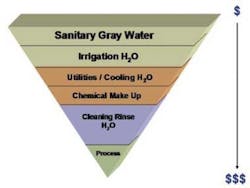Landing the Right Solution
A major expansion of the Bahamas airport faced the challenges of dealing with flat terrain and high levels of groundwater. Previously storm water runoff was retained and stored in open ditches until it evaporated. Gina Carolan explains how subsurface stormwater systems helped solve topography challenges during the project.
LLynden Pindling International Airport is the largest international gateway into the Bahamas. Located 16 km (10 mi.) to the west of the capital city of Nassau, it is named after the Right Honorable Sir Lynden Oscar Pindling, first Prime Minister of the Commonwealth of the Bahamas.
In 2007, the airport began a three-phase $400 million expansion and renovation. Airside improvements included new and reconstructed aircraft aprons, passenger piers, jet bridges, and infrastructure. Landside improvements included new and expanded access roads, parking facilities, revenue control systems, rental car and airport support buildings and new utilities infrastructure. Approximately 110 acres of the airport territory were under construction or renovation, including about 60 acres of airside and 50 acres of landside and terminal areas.
Going underground
The ground for the major construction was broken in the summer of 2009. A major challenge for the expansion was addressing the airport's stormwater management capacity. Previously, the airport's stormwater runoff was retained and stored in open ditches and swales until it slowly infiltrated or evaporated.
Frequent ponding or standing water would take several days to dissipate. As a result, heavy or extended rainfalls often caused frequent flooding of some areas of the airport. In addition to the ponds, the existing stormwater systems included several deep drainage wells, which reintroduced stormwater runoff into the ground approximately 45.72m below the surface.
Engineers from Stantec Architecture, who were involved in the design and renovation of the existing terminal buildings, had to replace and upgrade the existing drainage and stormwater systems on airside and landside areas.
In line with the Bahamas' stormwater regulations, the new systems had to be able to handle at least 0.15m of runoff over the entire drainage area or a rain event of 0.03-m (one-inch) intensity for a duration of six hours.
The airport presented significant challenges for stormwater management. The large site featured an extremely flat terrain, presenting no capacity for runoff. This topography resulted in long runs of level and very flat pitched slopes for pipes as well as shallow bury and cover requirements. While the site featured an easily workable limestone-based soil and limestone bedrock, the work was impacted by the high level of groundwater — about 1.83m below finished grade and 1m below existing ground. There was little opportunity for infiltration or for conveying stormwater in piped systems.
"The unique challenge was to provide sufficient storage to accommodate the runoff from large storms and include several deep drainage wells to rapidly dewater the systems," says Patrick Clark, project engineer with Stantec, who designed the airside and landside stormwater systems. The engineers found their solution in Cultec's subsurface stormwater chamber systems: dome-shaped, open-bottomed, corrugated units with perforated sidewalls. They serve as retention or detention systems and as replacements for ponds, concrete structures or pipe and stone installations.
A typical underground stormwater system includes the inlet, water quality device, conveyance device and storage chambers. The process begins with runoff entering a collective device, normally from a basin inlet structure. From the inlet, the stormwater then passes through a preventative maintenance device connected to the front end of the system.
Stormwater then enters a manifold system that conveys the runoff to the bed of stormwater chambers. Typically, a manifold consists of a pipe and fitting configuration; however, Cultec offers its own in-line side portal manifold that allows manifolding to take place at any point within the stormwater system. The custom manifold design condenses the system while decreasing the required footprint, allowing for maximum design flexibility and eliminating the need for costly fabricated pipe manifolds.
Two stage construction
Four of the systems were included in the design - two for the ongoing first phase of construction and another two for the second phase of construction planned for 2011-2012. CAD technologists worked with the engineers to identify the unit that would be the best fit for the project.
For phase one, it was determined that the Recharger® 180 HD stormwater chamber would provide the maximum storage given the site's restrictions. The Recharger 180 HD is 0.91m wide by 0.52m high, with a chamber storage capacity of 0.32m2 (3.45 CF/LF).
Rock and roll
Stantec used HydroCAD® modeling software to analyse the site and design the systems. The program already included the Recharger 180 HD parameters, so the engineers only needed to specify the 0.15-m (six-inch) layers of stone above and below the chambers for the first two systems.
The use of underground stormwater systems helped solve yet another project challenge: the hard durable rock needed for the installation would have to be imported to the Bahamas. By using less stone, the systems used helped lower the overall installation costs due to a lower imported rock requirement.
At Lynden Pindling International Airport, the stormwater systems function independently to distribute and balance the stormwater runoff. Each system features a unique storm drainage infrastructure, independent outlet control structures, and a system of new deep drainage wells for rapid dewatering of the systems.
Yet, the systems are also interconnected in the event that any one system reaches capacity or overflows through the outlet control structure. There are no physical outlets for the systems, so the chambers retain stormwater until dewatering is completed via new deep drainage wells. Additionally, the systems are connected to several open swales and retention ponds distributed throughout the site to allow for excess storage capacity. The open detention ponds are drained with deep drainage wells for rapid dewatering and to provide for infiltration and evaporation.
Storage capacity
Two Cultec systems provided combined 1,191m3 of storage. The storage volume per installed chamber was about 1m3 including the storage capacity of the stone.
The installation of the systems began with excavating two beds — a 930 m2 bed for one system and a 1,361 m2 bed for the other. Cultec's non-woven polypropylene filter fabric was laid along the sides and the bottoms of the beds followed by a layer of crushed stone. Once in place, the chambers were covered with crushed stone and a layer of filter fabric, and the site was then prepared for asphalt.
Both systems were installed in about three days and all systems were placed in the landside areas underneath passenger parking lots. According to Clark, the systems' underground installation prevented the loss of valuable square footage that would have otherwise been needed for open storage areas.
Stantec also designed separate drainage systems for airside facilities. These drainage systems must comply with the "U.S. NFPA 415: Standard on Airport Terminal Buildings, Fueling Ramp Drainage, and Loading Walkways" and include several large oil/water separators for spill protection from aircraft fueling operations. The airside stormwater systems also included several existing and new open drainage swales and basins for runoff storage.
Specific to the project, the systems were designed to work together with other stormwater management practices to capture and store large amounts of runoff onsite. According to Clark, the underground systems solved the challenges of flat terrain and high-level groundwater and allowed engineers to use the space above the systems for parking areas.
Author's note:Gina Carolan is C.O.O. and director of marketing at CULTEC, U.S.A. She can be reached at [email protected].
More Water & WasteWater International Current Issue Articles
More Water & WasteWater International Archives Issue Articles


